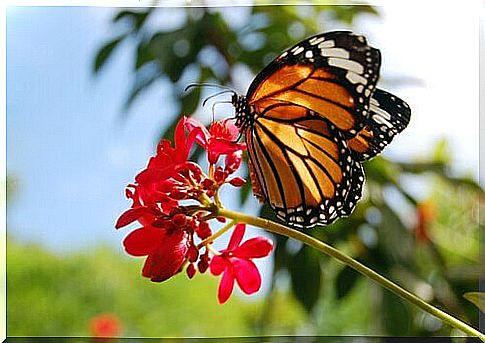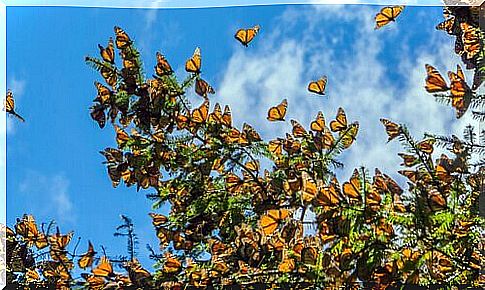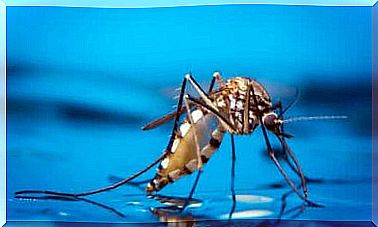The Monarch Butterfly And Its Incredible Odyssey

The monarch butterfly is one of the most famous species of butterflies in the world. This is due to its beautiful, orange color and the long journey it takes every year.
This insect is found almost all over the American continent, because it spreads from Canada to the north of South America.
The monarch butterfly and its color
The adult monarch butterfly ( Danaus archippus ) has a brilliant color. The upper part of its wings is orange with a black pattern. The lower part, on the other hand, has a subdued orange tone.
This different coloration helps the monarch butterfly to survive. With the lower part of the wings it can hide on tree bark or other surfaces.
The bright orange on the top warns predators of its unpleasant taste, as it stores toxins in its body.
This type of warning against predators is called aposematism or warning staining. This is an evolutionary strategy, as the majority of predators associate the colors orange and yellow with poison.
The monarch butterflies have cardiac glycosides stored inside their bodies. It is a substance that is poisonous to some animals. This butterfly receives it already in caterpillar age, when the young animals feed on a plant called Asclepias linaria .
However, there are also various birds and rodents that are immune to this substance.

The life cycle of the monarch butterfly
These butterflies can grow to be 8 to 10 cm and it is very easy to tell males from females. Males are a little larger and have a black spot in the center of each wing. Adult animals weigh about half a gram.
The monarch butterfly goes through four stages:
- It all starts with the female laying her eggs on the Asclepias plant. These are no more than two millimeters in size and hatch four to eight days later.
- The larvae then hatch from the eggs and feed on the leaf on which their mother laid them. They then become robust caterpillars with a yellow, black and white pattern on their bodies. Depending on how much they eat, they will stay in this state for about two weeks.
- When they have eaten enough, they begin to pupate so that they can turn into butterflies. The doll is light green, with gold polka dots and a black ribbon. This transformation takes 10 days.
- After the transformation is complete, the butterfly hatches. Its lifespan depends on when it is “born”. Those that hatch in spring or early summer live between two and six weeks.
However, if they hatch at the end of summer or the beginning of autumn, then they can live up to eight months. These are the monarch butterflies that make a long journey from Canada to Mexico and back again.
The journey of the monarch butterflies
The monarch butterflies, which are born at the end of summer, make a long journey from Canada to central Mexico or California.
You cover a distance of more than 5,000 km. They do this to flee from winter, which is why they make this trip every fall and fly back in spring.

There are two main travel routes for the animals. The most famous stretches from southern California to central Mexico, Michoacan. The second extends from southern Canada to the coast of California.
90% of monarch butterflies born in Canada take the first route, 10% leave the second route.
Your guide is the position of the sun and the intensity of the sunlight. However, it is a complete mystery to humans how this biological compass actually works. That’s because we don’t know how the butterflies process sunlight through their eyes.
Therefore this remains one of the great mysteries of the monarch butterfly’s journey.
Spread and threats
The North American monarch butterflies are the most famous, but they can also be found in other parts of the world. They can be found in northern South America (Venezuela and Colombia) and in southern Florida. In recent years they have also been introduced in Australia, New Zealand, Hawaii and Spain.
Nowadays the monarch butterfly is considered an endangered species as the traveling groups get smaller and smaller. The dwindling numbers are due to various factors, with humans being the most important trigger.
Due to deforestation, there are fewer and fewer Asclepias plants on which the caterpillars feed.
The past few decades have also shown that the use of weed killers in agriculture has reduced their population.









